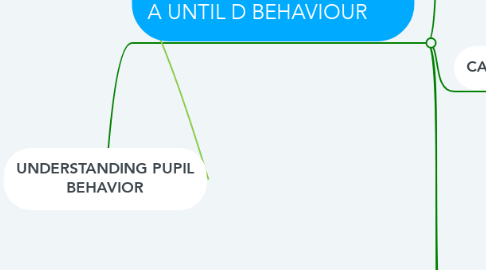
1. RESPONDING TO PUPILS MANIFESTING CATEGORY A UNTIL D BEHAVIOUR
1.1. CATEGORY A
1.1.1. RESPOND WITH
1.1.1.1. 1. GENERAL HINT
1.1.1.1.1. a. With Positive Focus (Personal and Communal Responsibility)
1.1.1.1.2. b. With Negative Focus (Personal and Communal Responsibility)
1.1.1.2. 2. SPECIFIC HINT
1.1.1.2.1. a. With Positive Focus (Personal and Communal Responsibility)
1.1.1.2.2. b. With Negative Focus (Personal and Communal Responsibility)
1.1.1.3. 3.RESTATEMENT OF ECPECTATION
1.1.1.3.1. a. With Positive Focus (Personal and Communal Responsibility)
1.1.1.3.2. b. With Negative Focus (Personal and Communal Responsibility)
1.1.1.4. 3. I-massages
1.1.1.4.1. a. With Positive Focus (Personal and Communal Responsibility)
1.1.1.4.2. b. With Negative Focus (Personal and Communal Responsibility)
1.1.1.5. 4. ASKING DIRECT QUESTION
1.1.1.5.1. a. for example ask "what are u doing?"
1.2. CATEGORY B
1.2.1. RESPOND WITH
1.2.1.1. 1. RECOGNIZING RESPONSIBLE BEHAVIOR
1.2.1.1.1. a. we have determined the behavioural pupils goals
1.2.1.1.2. b. deciding what consequences will apply
1.2.1.2. 2. WHEN PUPILS ACT RESPONSIBLY
1.2.1.2.1. a. using very specific verbal praise
1.2.1.2.2. b. using non-verbal praise
1.2.1.2.3. c. communication to their parents
1.2.1.3. 3. WHEN PUPILS ACT IRRESPONSIBLY
1.2.1.3.1. a. Is essential that pupils know in advance the consequences the teacher will use.
1.2.1.4. 4. INFORMING THE PUPIL
1.2.1.5. 5. RESPONDING TO INAPPROPRIATE BEHAVIOR
1.2.1.5.1. a. . identify the pupil
1.2.1.5.2. b. describe the behaviour
1.2.1.5.3. c. indicate which rights are being denied
1.2.1.5.4. d. demand responsible behaviour.
1.3. CATEGORY C
1.3.1. RESPOND WITH
1.3.1.1. 1. TALKING WITH PUPILS
1.3.1.2. 2. MAKE GOODWILL AND TALK
1.4. CATEGORY D
1.4.1. RESPOND WITH
1.4.1.1. 1. BASIC ASSUMPTION
1.4.1.2. 2. INAPPROPRIATE BEHAVIOR
1.4.1.3. 3. MAKING MISTAKEN GOALS

